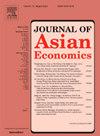Cost of escaping air pollution: A way to prevent excessive expansion of industrial areas
IF 2.9
3区 经济学
Q1 ECONOMICS
引用次数: 0
Abstract
To pursue economic growth, many emerging markets prioritize providing land and resources to industries rather than people, resulting in people being forced to relocate. This paper uses Taiwan’s largest industrial city (Kaohsiung) as an example to discuss the negative spillover effect brought about by its most polluted industrial area (the Kaohsiung Linhai Industrial Park, KLIP). This study finds that the proximity between residences and the pollution sources and air pollution severity both cause housing prices to decrease. The results also show that among different air pollution indicators, SO2 concentration exerts the largest influence on housing prices. This may be because the SO2 emitted by large coal-fired power plants and oil refineries in the KLIP is linked to pollution-based haze and creates a visible atmospheric brown haze. By discussing the industrial park’s air pollution problem, this paper illustrates the harm of the overdevelopment of an industrial park. To prevent people’s relocation events resulting from the overdevelopment of an industrial park occurring in the future, we must regularly estimate the shadow price that residents living near the industrial park are required to pay to escape air pollution. This paper also puts forward suggestions that contribute to the sustainable development of industrial parks.
逃避空气污染的代价:防止工业区过度扩张的方法
为了追求经济增长,许多新兴市场将土地和资源优先提供给工业而非人口,导致人口被迫迁移。本文以台湾最大的工业城市(高雄)为例,探讨其污染最严重的工业区(高雄临海工业区)所带来的负面溢出效应。研究发现,住宅与污染源的距离和空气污染的严重程度都会导致房价下降。结果还显示,在不同的空气污染指标中,二氧化硫浓度对房价的影响最大。这可能是因为吉隆坡工业园区内的大型燃煤电厂和炼油厂排放的二氧化硫与污染型雾霾有关,并在大气中形成可见的棕色雾霾。本文通过讨论工业园区的空气污染问题,说明了工业园区过度开发的危害。为了防止未来发生因工业园区过度开发而导致的居民搬迁事件,我们必须定期估算工业园区附近居民为躲避空气污染而需要付出的影子价格。本文还提出了有助于工业园区可持续发展的建议。
本文章由计算机程序翻译,如有差异,请以英文原文为准。
求助全文
约1分钟内获得全文
求助全文
来源期刊

Journal of Asian Economics
ECONOMICS-
CiteScore
4.70
自引率
9.40%
发文量
90
期刊介绍:
The Journal of Asian Economics provides a forum for publication of increasingly growing research in Asian economic studies and a unique forum for continental Asian economic studies with focus on (i) special studies in adaptive innovation paradigms in Asian economic regimes, (ii) studies relative to unique dimensions of Asian economic development paradigm, as they are investigated by researchers, (iii) comparative studies of development paradigms in other developing continents, Latin America and Africa, (iv) the emerging new pattern of comparative advantages between Asian countries and the United States and North America.
 求助内容:
求助内容: 应助结果提醒方式:
应助结果提醒方式:


